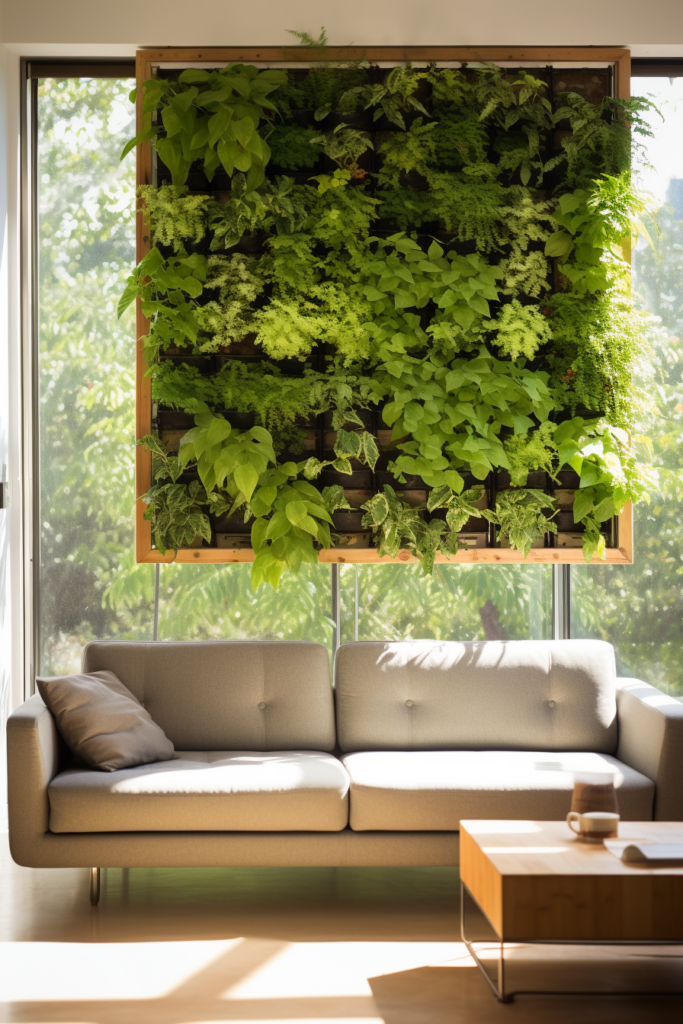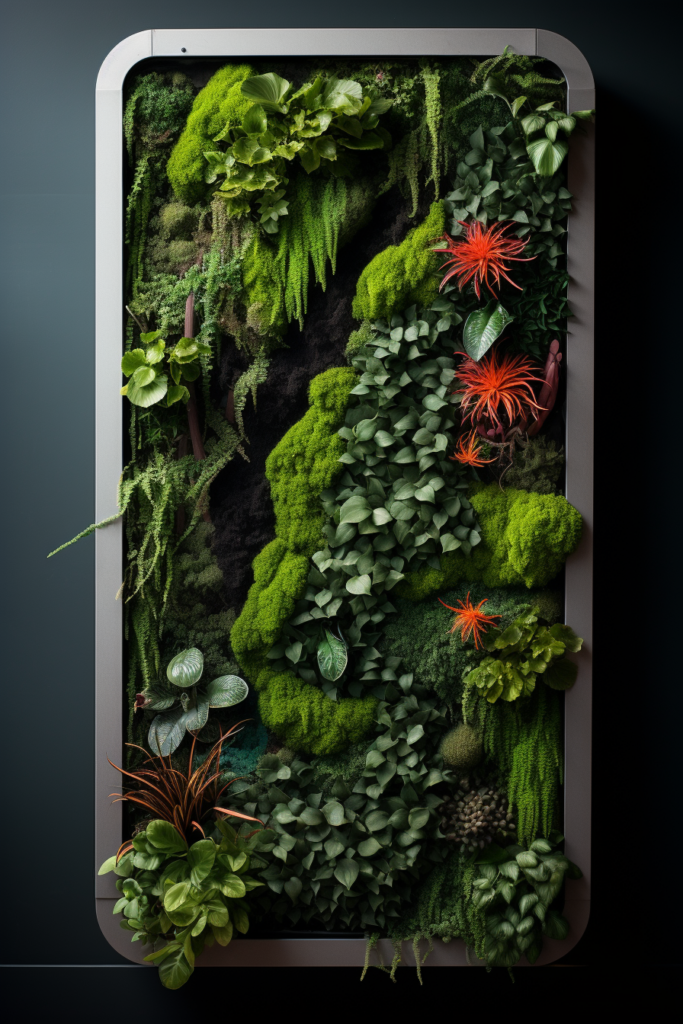Vertical gardens and greenery are becoming increasingly popular decorative elements in interior design. Incorporating living plants into the home provides numerous benefits – they purify the air, reduce stress, add beautiful pops of color and texture, and can transform any blank wall into a lush, refreshing oasis.

This comprehensive guide will explore how to successfully install and maintain a stunning vertical garden or “living wall” in your home. We will cover everything from choosing the right plants, building the structure, setting up irrigation, and more. Follow along step-by-step to create your own indoor paradise.
Benefits of Indoor Vertical Gardens


Vertical gardens offer many advantages beyond just aesthetics. Having thriving plants in your living environment improves air quality by filtering out pollutants. Studies show being around nature reduces stress and blood pressure levels.
The increase in humidity from transpiration is healthy for the skin and sinuses. Plants also help soundproof spaces and can provide insulation.
Greenery brightens up any area with pops of color, interesting textures, and visual depth. Flowers add delightful scents. You can grow edible herbs or miniature vegetables. The options are endless when designing a custom vertical garden to enhance your home.
- Vertical gardens filter the air, reduce stress, add humidity, insulate, and provide endless design possibilities with their colors, textures, scents, and edibles.
Choosing a Location


When selecting a spot for your vertical garden, the most important factor is light exposure. Most indoor plants need bright, indirect sunlight for several hours per day. South, east, and west-facing walls near lightly shaded windows are ideal. Supplement with grow lights if needed.
Consider accessibility – the structure should be easily reachable for maintenance. Pay attention to plumbing and electrical lines hidden behind walls to avoid damage. Vertical gardens add moisture to a room, so keep furnishings an appropriate distance away. Place it somewhere the plants can be admired!
- Position vertical gardens with bright, indirect light near windows on accessible walls without hidden electrical/plumbing.
- Keep furnishings away from moisture and place plants where they can be enjoyed.
Structural Considerations


The vertical garden structure provides crucial support, stability, and an attachment medium for your plants to climb on. Use weather-resistant backing like galvanized steel, exterior plywood sealed with waterproof stain, or moisture-proof rigid panels. Affix these to wall studs for maximum sturdiness.
Build a frame around the edges using aluminum bars. This prevents sagging while keeping the system self-contained. Line inside with plastic sheeting to prevent leaks. Attach fleece layers, mesh, or lattice overlapped like shingles for plants to take root in.
Include spacers to allow air circulation between the wall and the structure.
Fun finishes like decorative trim can help the system blend into your existing décor. Just ensure every component can withstand moisture.
- Weatherproof backing on the wall, edged by a rigid frame and overlapped plantable layers, allows vertical gardens to support thriving plants without leaks or sagging.
Irrigation Methods


Vertical gardens require consistent moisture for luscious growth. While some very drought-tolerant plants may survive occasional waterings, most require specialized irrigation provided by:
- Drip System – Drip tubing with emitters releases small, targeted streams along the entire installation. Place emitters every 3-6 inches near each plant’s base.
- Sub-irrigation – Wicking materials draw water up vertically from reservoirs. I felt layers work well. Ensure the bottom edge makes constant contact with water.
- Manual Watering – Using spray bottles allows precision targeting of thirsty plants as needed between deep hand waterings. Set reminders to maintain consistency.
- Automatic Misting – Programmable misters mounted along the top of installations lightly shower the entire system on customized schedules. Recirculating pumps prevent overflow.
- Consistent moisture comes from drip emitters, wicking fabric reaching reservoirs, spray bottles targeting individual plants, or automatic misters on timers.
Lighting Conditions


While the ideal vertical garden location places plants by natural light sources, many spots lack sufficient sunlight. Supplement with full-spectrum, grow light LED panels in 6500K temperatures. Cooler blue/purple tones encourage leafy growth, while warmer reds trigger blooms.
Mount panels above installations, focusing beams over all plants. Set lights on 12-14 hour timers mimicking outdoor conditions. Slowly introduce lighting over a week to avoid shock. Observe plant health, adjusting duration as needed.
For simpler, smaller gardens, flexible LED light strips also provide full spectrum color. Weave these liberally throughout the structure or incorporate lighting behind opaque panels for a luminous glow.
- Mimic outdoor light conditions with supplemental grow light panels on timers or by weaving full-spectrum LED strips throughout vertical gardens lacking sufficient natural light.
Air Circulation Considerations


Proper airflow prevents moisture buildup leading to mold, fungus, and decay – risks heightened by the elevated humidity of vibrant vertical gardens. Ensure structures allow room for airflow behind the wall.
Use spacers between backing and overlapped plantable layers.
Strategically place small fans out of sight, circulating air around installations. Run these simultaneously with misting systems on automatic timers. Use moisture barriers like mini dehumidifiers to protect walls in excessively damp climates.
Leaf trimming maintains ideal density, allowing light and air to permeate. Prune plants touching walls redirecting growth outward. Remove yellowing lower leaves by hand regularly. Use micro-pruning snips for detail work, avoiding large shearers that injure stems.
- Air circulates behind vertical gardens on spacers.
- Fans run with misters on timers.
- Pruning maintains light and airflow, redirecting plants touching walls.
Plant Selection

Match plants to available lighting and vertical space. Shade lovers like ferns flourish under sheltering pergolas beside windows, while cacti and succulents thrive in direct southern exposure. Trailing vines shine brightly on brilliant backdrops.
Seeking harmony, combine plants sharing similar light and watering needs for ease of care. Use fast-growing trailing plants like Pothos to fill in amongst showstoppers like Monstera deliciosa. Mix and match textures and colors for visual interest.
When planting, don’t overcrowd. Allow each plant adequate room to grow into its space – only fill half the pockets at first. As vines stretch out, move plantings around, creating beautiful living artwork.
- Takeaway 7:
- Combine plants with similar needs organized by height and growth speed.
- Mix colors and textures harmoniously, allowing room to fill space over time by moving vines while planting gradually.
Installation Best Practices


When installing plants, gently loosen root balls prior to placing them into pockets, shaking off excess soil. Pack surroundings with light, airy blends containing compost or coconut coir supporting drainage. Or simply tuck cutting directly into felt pockets sandwiched together without soil. Spritz leaves well after planting.
Make small slits in outer pockets to thread vines through once rooted. Wrap stems gently without strangling them as plants grow taller. Add custom trellises anchored in the base structure for extra climbing support.
Mist thoroughly avoiding outer wall exposure immediately after installation for two weeks until plants are established. Soak the base weekly for a few months until watering needs are apparent. Observe plant health closely, adjusting as necessary.
- Loosen roots, pack breathable soil blends, and insert cuttings into felt or simply water-rooted plants daily, initially for establishment success.
Maintenance

Vertical gardens require some routine maintenance but offer great rewards. Check soil moisture weekly by finger test – soak thoroughly, allowing excess to drain out. Leach salts monthly, flushing the entire system. Wipe leaves with a soft cloth soaked in mild, soapy water or neem oil, deterring pests. Spot treat problems early.
Remove yellowed foliage and trim vines ASAP, not allowing decaying plant matter to accumulate. Rinse out hanging planters between waterings, preventing salt buildup. Apply balanced liquid fertilizers tailored to plant varieties monthly during the growing season.
Monitor for pests weekly. Isolate and discard afflicted plants immediately, replacing them with fresh cuttings to maintain your living art installation gorgeously. Rejuvenate plants by pruning overgrowth or propagate by trimming vines for new plants regularly.
- Takeaway 9:
- Balance moisture, treat pests ASAP, trim decaying matter promptly, fertilize and propagate plants seasonally, and maintain vertical garden beauty through attentive care.
Additional Decor Touches


Beyond lush greenery, add extra personality and visual intrigue with colorful potted accent plants placed at the base of vertical garden installations. Mix heights with tabletop and hanging varieties. Use trellises and arbors atop shorter shelves to train vines upwards.
Incorporate glass containers and transparent planting pockets to display decorative materials like marbles or seashells behind installations. Show off sculpture or ceramic art pieces throughout the composition.
Use integrated lighting to highlight architectural elements or subtly backlight opaque panels. Attach bird or butterfly attractions, securing these near upper windows and enjoying nature’s lively presence.
Finally, have fun changing out seasonal cut flowers and ornamental branches utilizing built-in vases, keeping vertical gardens eternally fresh. The possibilities are endless!
- Accent plants, sculptures, container designs, lighting, seasonal flowers, and wildlife habitats further enhance vertical garden installations with personal flair.
10 Best Plants for Vertical Gardens
- Philodendrons – Fast-growing, trailing
- Pothos – Easy care, shingle naturally
- Monstera – Visually striking leaves
- Ferns – Graceful and texture-rich
- English Ivy – Trails attractively
- Arrowhead Vine – Ornamental leaves
- Wandering Jew – Colorful foliage
- Mosses – Lush and whimsical
- Air Plants – Uniquely adaptable
- Succulents – Sculptural drought-tolerant varieties
Conclusion
Creating living art through gorgeous vertical garden installations brings delightful greenery indoors. Strategically positioned, thoroughly watered, and artfully designed, they provide natural beauty, purifying inner spaces for healthier, happier living. With proper care and creative customization, vertical gardens flourish, bathing homes in abundant green sophistication.
Follow Quiet Minimal on Pinterest for more home design tips and inspiration.


